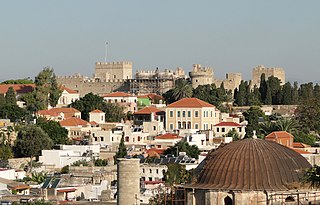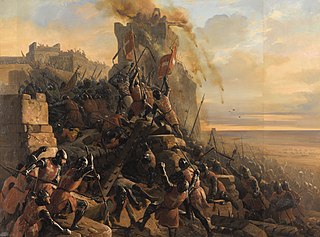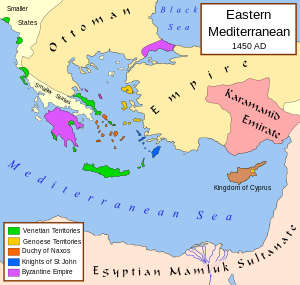
Rhodes is the principal city and a former municipality on the island of Rhodes in the Dodecanese, Greece. Since the 2011 local government reform, it is part of the municipality Rhodes, of which it is the seat and a municipal unit. It has a population of approximately 56,000 inhabitants. Rhodes has been famous since antiquity as the site of Colossus of Rhodes, one of the Seven Wonders of the Ancient World. The citadel of Rhodes, built by the Hospitalliers, is one of the best-preserved medieval towns in Europe. The Medieval city is designated as a UNESCO World Heritage Site.

Martino Zaccaria was the Lord of Chios from 1314 to 1329, ruler of several other Aegean islands, and baron of Veligosti–Damala and Chalandritsa in the Principality of Achaea. He distinguished himself in the fight against Turkish corsairs in the Aegean Sea, and received the title of "King and Despot of Asia Minor" from the titular Latin Emperor, Philip II. He was deposed from his rule of Chios by a Byzantine expedition in 1329, and imprisoned in Constantinople until 1337. Martino then returned to Italy, where he was named the Genoese ambassador to the Holy See. In 1343 he was named commander of the Papal squadron in the Smyrniote crusade against Umur Bey, ruler of the Emirate of Aydin, and participated in the storming of Smyrna in October 1344. He was killed, along with several other of the crusade's leaders, in a Turkish attack on 17 January 1345.

Guillaume de Villaret, was the twenty-fourth Grand Master of the Knights Hospitaller, a position he held from 1296 until 1305, succeeding Odon de Pins. He was succeeded by his nephew, Foulques de Villaret, whose career he had done much to advance.

Foulques de Villaret, was the 25th Grand Master of the Knights Hospitaller. He led the successful conquest of Rhodes and survived an assassination attempt by members of his own order.

In 1480 the small Knights Hospitaller garrison of Rhodes withstood an attack of the Ottoman Empire.

The history of Rhodes under the Order of Saint John lasted from 1310 until 1522. The island of Rhodes was a sovereign territorial entity of the Knights Hospitaller who settled on the island from Palestine and from Cyprus, where they did not exercise temporal power. The first Grand Master was the French Foulques de Villaret (1305–1319).

Jean de Villiers was the twenty-second grand master of the Knights Hospitaller, serving from 1285 until 1293. He was elected Grand Master after the death of Nicolas Lorgne. De Villiers was Prior of France beginning in 1282 and he remained in France to deal with existing problems of the Order. Jacques de Taxi became Grand Master ad interim, perhaps through 27 June 1286, while awaiting the arrival of the newly elected Grand Master in the Holy Land. De Villiers was present at the Siege of Acre in 1291, but escaped just before the city fell to the Mamluks. He was succeeded by Odon de Pins.
Geoffroy de Thoisy, chevalier seigneur de Mimeure, was a Burgundian naval commander and Knight of the Order of the Golden Fleece involved in Philip the Good’s Crusade endeavors in the 1440s.
The Genoese occupation of Rhodes refers to the period between 1248 and late 1249/early 1250 during which the city of Rhodes and parts of the namesake island were under Genoese control. The Genoese took possession of the city and island, a dependency of the Empire of Nicaea, in a surprise attack in 1248, and held it, with aid from the Principality of Achaea, against Nicaean attacks until 1250.
Albert of Schwarzburg, in contemporary sources also Albertus Alamanus or Albertus de Nigro Castro, was a member of the Saxon–Thuringian House of Schwarzburg who became a member of the Knights Hospitaller, rising to be marshal and grand preceptor of the Order, and fighting with success against the Turks.

Maurice of Pagnac was a member of the Knights Hospitaller who was briefly installed as Grand Master in 1317–19, after the Order overthrew Foulques de Villaret. His election was not recognized by Pope John XXII, who re-installed Villaret.
Andrea Morisco was a Genoese pirate active in the Aegean Sea in the late 13th century, who in 1304 entered the service of the Byzantine Empire. As an admiral and corsair, he was active under Byzantine colours until 1308, when he was captured and executed in Cyprus.

The Hospitaller conquest of Rhodes took place in 1306–1310. The Knights Hospitaller, led by Grand Master Foulques de Villaret, landed on the island in summer 1306 and quickly conquered most of it except for the city of Rhodes, which remained in Byzantine hands. Emperor Andronikos II Palaiologos sent reinforcements, which allowed the city to repel the initial Hospitaller attacks, and persevere until it was captured on 15 August 1310. The Hospitallers transferred their base to the island, which became the centre of their activities until it was conquered by the Ottoman Empire in 1522.
The Battle of Amorgos occurred in 1312 between the fleets of the Knights Hospitaller and of the Turkish beylik of Menteshe. The battle was a Hospitaller victory, but both sides suffered heavy losses.

The siege of Smyrna was fought between the Knights of Rhodes, who held the harbour and sea-castle of Smyrna in western Anatolia, and the army of the Turco-Mongol emir Timur. The Turco-Mongols blockaded the harbour and attacked the fortifications with stone-throwing siege engines, while the defenders, numbering only about 200 knights, countered with arrows and incendiary projectiles. After two weeks of strong resistance against a far superior adversary, the outer wall was destroyed by mining and breached. Some of the garrison managed to escape by sea, but the inhabitants and the city itself were destroyed.
The Crusade of the Poor was an unauthorised military expedition—one of the so-called "popular crusades"—undertaken in the spring and summer of 1309 by members of the lower classes from England, Flanders, Brabant, northern France and the German Rhineland. Responding to an appeal for support for a crusade to the Holy Land, the men, overwhelmingly poor, marched to join a small professional army being assembled with Papal approval. Along the way, they engaged in looting, persecution of Jews and combat with local authorities. None of them reached the Holy Land and their expedition was ultimately dispersed.
The chronology of the later Crusades through 1400 provides a detailed timeline of the Crusades from after the Eighth Crusade, the last of the major expeditions to the Holy Land through the end of the 14th century. This includes the events from 1270 on that led to the Fall of Outremer in 1291 and the Crusades after Acre, 1291–1399.

The Crusades after Acre, 1291–1399 represent the later Crusades that were called for by papal authorities in the century following the fall of Acre and subsequent loss of the Holy Land by the West in 1302. These include further plans and efforts for the recovery of the Holy Land, the later popular Crusades, Crusades against Christians, political Crusades, the latter parts of the Reconquista, and the Northern Crusades. Crusades were to continue well into the fifteenth century and would include those against the Ottoman Empire.

Guillaume Caoursin, also called Gulielmus Caoursin, was vice-chancellor of the Order of Saint John of Jerusalem, or Knights Hospitaller. He was an eye-witness to the siege of Rhodes in 1480, an unsuccessful attack on the Hospitaller garrison led by Pierre d'Aubusson by an Ottoman fleet of 160 ships and an army of 70,000 men under the command of admiral Mesih Pasha.

The history of the Knights Hospitaller in the Levant is concerned with the early years of the Order of the Hospital of St. John of Jerusalem, the Knights Hospitaller, through 1309. The Order was formed in the later part of the eleventh century and played a major role in the Kingdom of Jerusalem, in particular, the Crusades. This lasted until the West was expelled from the Holy Land, with the Order conquering Rhodes in the early fourteenth century. Among the most important internal events of the early years of the kingdom were the foundation of the Military Orders, which included the Hospitallers, the Knights Templar and the Teutonic Order. Unlike the Hospitallers' beginnings as a benevolent organization, the Templars and Teutonic knights began with a military mission. These three major Orders would play a major role in the military activities of the kingdom, sometimes cooperatively, sometimes not. On the battlefield they frequently shared among them the most important tactical roles, the vanguard and rear-guard.

















